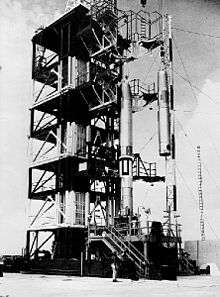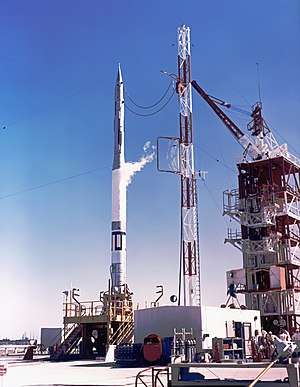Vanguard SLV-5
Vanguard SLV-5, also called Vanguard Satellite Launch Vehicle-Five hoped to be the third successful flight of the American Vanguard rocket following the successful Vanguard 2 satellite on rocket Vanguard SLV-4. Vanguard SLV-5 launched on 14 April 1959 at 02:49 GMT, from Launch Complex 18A at the Cape Canaveral Air Force Station. A momentary delay in first stage separation caused the second stage engine to ignite while still attached to the first stage. Pressure from the engine exhaust pushed the thrust chamber to the limit of the gimbal stops, breaking them and causing loss of attitude control in flight. The second stage tumbled and the resultant forces caused a premature separation of the third stage and payload. Data was received from them until impact in the Atlantic Ocean eight minutes after liftoff.[1] [2] [3][4]


Vanguard SLV-5 hoped to put into orbit two satellites: the Vanguard 3A satellite, a magnetometer, and a 76 cm (30 in) round inflatable sphere with an air density measurement device. Vanguard SLV-5 only reached an altitude of 100 km (62 mi); the goal was 3,840 km (2,390 mi) to orbit.[5] [6]
See also
References
Further reading
- Mallove, Eugene F. and Matloff, Gregory L. The Starflight Handbook: A Pioneer's Guide to Interstellar Travel, Wiley. ISBN 0-471-61912-4.